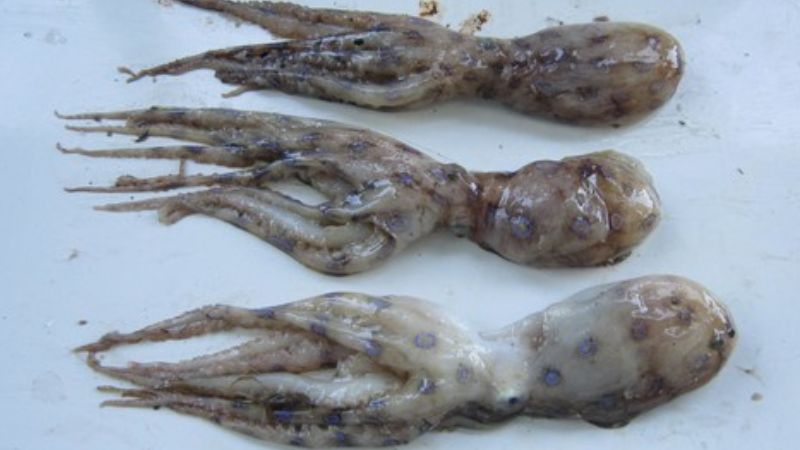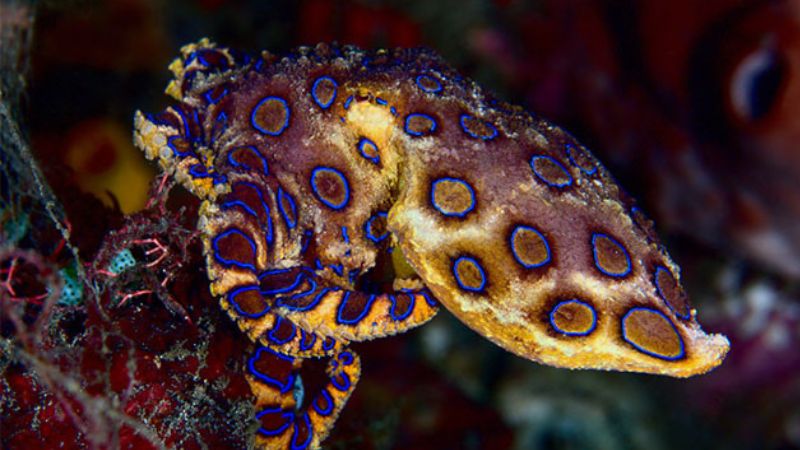The blue-ringed octopus is a highly dangerous species known for its toxic venom. To learn more about the risks associated with this octopus species, please read the following article.
1 What is the blue-ringed octopus?
The blue-ringed octopus is a unique and venomous species of octopus easily recognized by its blue rings. It primarily feeds on small animals such as crabs, shrimp, and other crustaceans.
Considered the world’s most poisonous marine creature, the blue-ringed octopus is relatively small in size but can be dangerous to humans when threatened. Its venom contains a potent neurotoxin called tetrodotoxin.
 Blue-ringed octopus
Blue-ringed octopus
The blue-ringed octopus is characterized by its yellow skin and distinctive blue markings. It typically measures between 12 to 20 cm in size and primarily consumes crustaceans.
The coloration of the blue-ringed octopus can change in response to sunlight or water depth, becoming more vibrant when agitated or preparing to attack.
This species is predominantly found in the Pacific Ocean and the Indian Ocean. While generally gentle and docile, it poses a significant danger to humans if provoked and is recognized as one of the most poisonous marine creatures.
The blue-ringed octopus belongs to the Hapalochlaena genus and consists of four species:
- Hapalochlaena fasciata: the blue-ringed octopus
- Hapalochlaena lunulata: the larger blue-ringed octopus
- Hapalochlaena maculosa: the southern blue-ringed octopus
- Hapalochlaena nierstraszi
 The blue-ringed octopus is very dangerous
The blue-ringed octopus is very dangerous
2 Toxicity of the blue-ringed octopus
Venom
The venom of the blue-ringed octopus remains potent even at high temperatures or after death. It primarily contains tetrodotoxin found in the saliva and other soft parts of the octopus’s body. Just 25g of its venom can kill more than 10 people weighing over 70kg.
Consuming the meat of the blue-ringed octopus can lead to symptoms within 30 minutes to 3 hours, including discomfort, facial redness, constricted pupils, nausea, diarrhea, limb weakness, chills, numbness in the head and fingers. Contact with the skin can cause symptoms within 1 to 5 minutes and potentially result in death within 10 to 20 minutes.
The venom of the blue-ringed octopus contains tetrodotoxin, histamine, tryptamine, octopamine, taurine, and acetylcholine. When threatened, the species will attempt to flee, but if the danger persists, its blue rings will become prominent.
 Venom
Venom
Reactions
The tetrodotoxin venom of the blue-ringed octopus is highly dangerous to humans, causing complete body paralysis. Victims may experience symptoms such as nausea, respiratory failure, cardiac arrest, and in severe cases, total body paralysis, blindness, and even death.
 Tetrodotoxin venom of the blue-ringed octopus is very dangerous
Tetrodotoxin venom of the blue-ringed octopus is very dangerous
Treatment
In the event of blue-ringed octopus poisoning, immediate pressure should be applied to the wound, and artificial respiration administered if the victim experiences breathing difficulties. Medical facilities may employ the use of a ventilator to aid in the removal of venom from the body.
 Treatment
Treatment
Currently, there is no known cure for blue-ringed octopus bites. It is advised to avoid contact with blue-ringed octopuses and refrain from consuming dishes made from this species of octopus.






























